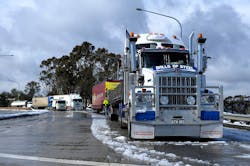WASHINGTON. Australia is in the process of eliminating pay by the mile for many of its truck drivers, and replacing it with guaranteed minimum hourly wages, a program the government is calling “safe rates.”The program was approved last month by that government’s Road Safety Remuneration Tribunal and will go into effect on April 4 for owner-operators who are in the long-haul and food services market sectors.Two speakers at a panel session at the Transportation Research Board’s 95th annual meeting here this week provided details of the program. Glenn Sterle, a member of the Australian senate and a supporter of the program, said the safe rates program is the culmination “of 20 years of hard work” by a bipartisan coalition of legislators who were looking to improve highway safety in the country.The first fruit of that effort, he said, was the national legislature’s 2012 creation of the RSRT as a tripartite panel comprised of government, fleet and labor representatives. The agency said it is also currently at work at extending the hourly-wage requirement to drivers who work in drayage, waste management and fuel sectors.Tony Sheldon, national secretary of Australia’s Transport Workers’ Union, said his country records an average of 330 heavy-truck-related fatalities a year and that trucking is by far the most dangerous occupation in the land, “11 times higher than any other industry.”He said a union survey found that 33% of drivers surveyed admitted that they had used stimulants in the past year in order to keep driving when fatigued. Sheldon said the survey might well have understated the actual percentage of drivers who take the drugs.Sheldon said Australian law now permits owner-operators to bargain collectively with fleets, and that as a result about 23% of all drivers are union members. Union membership at American fleets is about 8% by comparison, according to Michael H. Belzer, a professor at Wayne State University who has written extensively about trucking and chaired the TRB panel where the Australians spoke.The annual meeting of TRB, which is part of the National Academies of Sciences, Engineering and Medicine, attracted more than 12,000 attendees here for the five days of panels and workshops that run through Thursday.Sheldon said “supply-chain pressures” led to the demand for more speed and lower costs, which “causes drivers to engage in unsafe practices.”The safe-rates program is designed to ensure drivers that they will be paid for their labors, despite loading delays or congestion and would remove the incentives for engaging in those unsafe practices, he said.According to the union, the RSRP’s wage ruling for the first time requires fleets to pay drivers for all waiting time to load and unload, all time lost to road congestion and the time it takes to service, clean and inspect trucks and trailers.The Australian legislature created the RSRT tribunal in 2012 specifically to examine truck safety issues and to propose solutions.The trucking market in Australia is much smaller than North America’s, but does have things in common, including long distances between major cities and the use of similar equipment. The largest heavy-duty truck brands in Australia are Kenworth and Volvo.Sheldon said the adoption of hourly pay has led to some dramatic changes, including one port where average loading delays faced by drivers have fallen to 23 minutes from more than seven hours when drivers were paid by the kilometer.Sterle, who identified himself as a former truck driver and the son and father of truck drivers, said, “If we save one, two, three or four lives … “the safe rates program will be worthwhile.The initial safe rates program will run for four years, until April 3, 2020.Sheldon said the Japanese government and safety groups in Europe have expressed interest in Australia’s safe-rates program.The two Australian speakers were part of a four-hour, three-panel session entitled “Economic Competition, Commercial Motor Vehicle Safety and Driver Health” that was moderated by Belzer.
About the Author
Sign up for our eNewsletters
Get the latest news and updates
